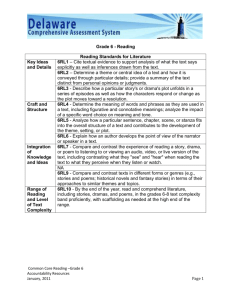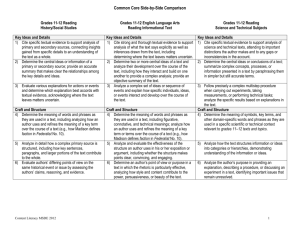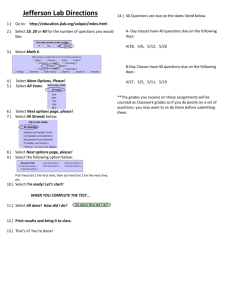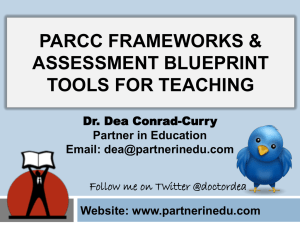Dr. Curry 9-18-2013 Informational Presentation
advertisement
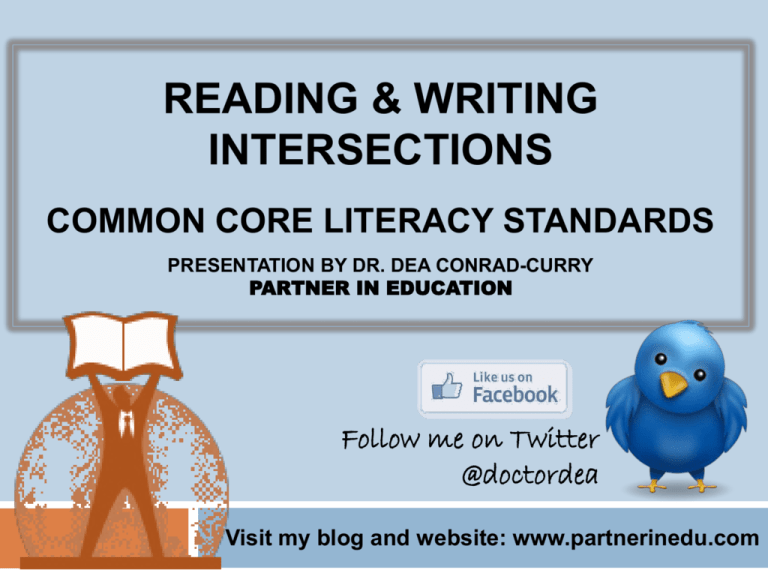
READING & WRITING INTERSECTIONS COMMON CORE LITERACY STANDARDS PRESENTATION BY DR. DEA CONRAD-CURRY PARTNER IN EDUCATION Follow me on Twitter @doctordea Visit my blog and website: www.partnerinedu.com Today’s Objectives Explain the organization of the Common Core reading and writing standards Describe the dependence of the Common Core reading standards on the Common Core writing standards Apply a model for connecting reading and writing in your classroom and discipline of study THAT supports the standards & assessment © 2013 Partner in Education Organization of the CCSS ELA Standards STRANDS Reading Literature & Informational Writing Speaking/ Listening Language CCR Anchor Standard CCR Anchor Standard CCR Anchor Standard CCR Anchor Standard 1. 2. 3. Key Ideas & Details 4. 5. 8. 9. 10. 2. Craft & Structure 5. 6. Integration of Knowledge & Ideas Text Complexity 1. Text Types & Purpose 2. 3. 3. 4. 6. 7. 1. 7. 8. 9. 10. 4. Production & Distribution of Writing 5. 6. Comprehension & Collaboration 1. Presentation of Knowledge & Ideas 3. Research to Build Knowledge 2. 4. 5. 6. Conventions of Standards English Knowledge of Language Vocabulary Acquisition & Use Range of Writing K-5 FOUNDATIONAL SKILLS • Print Concepts • Phonological Awareness • Phonics and Word Recognition • Fluency Office ofGraphic Special Education designed by Chicago and PublicSupports Schools Office of Special Education and Supports 3 Reading Anchor Standards Organized by Strand Specific CCR Sets 4 READING Key Ideas and Details Craft and Structure Integration of Knowledge & Ideas Range of Reading & Text Complexity © 2012-2013 Partner in Education Writing Anchor Standards Organized by Strand Specific CCR Sets 5 WRITING Types and Purposes Production and Distribution Research to Build & Present Knowledge Integration of Knowledge & Ideas Range of Writing © 2012-2013 Partner in Education ELA Model Content Frameworks 2012 6 Slide Copyright 2013 Partner in Education Source: PARCC Model Content Frameworks for ELA/Literacy, Grades 3-11. (2012, November) How will PARCC assessment be structured? Student summative performance levels will be based on the Performance-Based Component AND Endof-Year component 7 Slide Copyright 2013 Partner in Education Three Types of Student Response 8 1. Evidence-Based Selected-Response Designed to measure reading 2. Technology-Enhanced ConstructedResponse Designed to measure reading 3. Prose Constructed-Response Designed to measure reading & writing Slide Copyright 2013 Partner in Education Key Ideas & Details (Reading Standards for Informational Text) Grade K Grade 1 Grade 2 1. With prompting and 1. Ask and answer support, ask and answer questions about key details questions about key details in a text. in a text. 1. Ask and answer such questions as who, what, where, when, why, and how to demonstrate understanding of key details in a text. 2. With prompting and support, identify the main topic and retell key details of a text. 2. Identify the main topic and retell key details of a text. 2. Identify the main topic of a multi-paragraph text as well as the focus of specific paragraphs within the text. 3. With prompting and support, describe the connection between two individuals, events, ideas, or pieces of information in a text. 3. Describe the connection between two individuals, events, ideas, or pieces of information in a text. 3. Describe the connection between a series of historical events, scientific ideas or concepts, or steps in technical procedures in a text. © 2013 Partner in Education 9 Key Ideas & Details (Reading Standards for Informational Text) Grade 3 Grade 4 1. Ask and answer questions to demonstrate understanding of a text, referring explicitly to the text as the basis for the answers. 1. Refer to details and examples in a text when explaining what the text says explicitly and when drawing inferences from the text. 1. Quote accurately from a text when explaining what the text says explicitly and when drawing inferences from the text. 2. Determine the main idea of a text; recount the key details and explain how they support the main idea. 2. Determine the main idea of a text and explain how it is supported by key details; summarize the text. 2. Determine two or more main ideas of a text and explain how they are supported by key details; summarize the text. 3. Describe the relationship between a series of historical events, scientific ideas or concepts or steps in technical procedures in a text, using language that pertains to time, sequence, and cause/effect. 3. Explain events, procedures, ideas, or concepts in a historical, scientific, or technical text, including what happened and why, based on specific information in the text. 3. Explain the relationships or interactions between two or more individuals, events, ideas, or concepts in a historical, scientific, or technical text based on specific information in the text. © 2013 Partner in Education Grade 5 10 Key Ideas & Details (Reading Standards for Informational Text) Grade 6 Grade 7 Grade 8 1. Cite textual evidence to support analysis of what the text says explicitly as well as inferences drawn from the text. 1. Cite several pieces of textual evidence to support analysis of what the text says explicitly as well as inferences drawn from the text. 1. Cite the textual evidence that most strongly supports an analysis of what the text says explicitly as well as inferences drawn from the text. 2. Determine a central idea of a text and how it is conveyed through particular details; provide a summary of the text distinct from personal opinions or judgments. 2. Determine two or more central ideas in a text and analyze their development over the course of the text; provide an objective summary of the text. 2. Determine a central idea of a text and analyze its development over the course of the text, including its relationship to supporting ideas; provide an objective summary of the text. 3. Analyze in detail how a key individual, event, or idea is introduced, illustrated, and elaborated in a text (e.g., through examples or anecdotes). 3. Analyze the interactions between individuals, events, and ideas in a text (e.g., how ideas influence individuals or events, or how individuals influence ideas or events). 3. Analyze how a text makes connections among and distinctions between individuals, ideas, or events (e.g., through comparisons, analogies, or categories). © 2013 Partner in Education 11 READING STANDARDS FOR HISTORY / SOCIAL STUDIES GRADES 6-12 Grades 6-8 Students Grades 9-10 Students Grades 11-12 Students 1. Cite specific textual evidence to support analysis of primary and secondary sources 1. Cite specific textual evidence to support analysis of primary and secondary sources, attending to such features as the date and origin of the information. 1. Cite specific textual evidence to support analysis of primary and secondary sources, connecting insights gained from specific details to an understanding of the text as a whole. 2. Determine the central ideas or information of a primary or secondary source; provide an accurate summary of the source distinct from prior knowledge or opinions. 2. Determine the central ideas or information of a primary or secondary source; provide an accurate summary of how key events or ideas develop over the course of the text. 2. Determine the central ideas or information of a primary or secondary source; provide an accurate summary that makes clear the relationship among key ideas and details. 3. Identify key steps in a text’s description of a process related to history/social studies (e.g. how a bill becomes law, how interest rates are raised or lowered). 3. Analyze in detail a series of events described in a text; determine whether earlier events caused later ones or simply preceded them. 3. Evaluate various explanations for actions or events and determine which explanation best accords with textual evidence, acknowledging where the text leaves matters uncertain. Key Ideas and Details 12 READING STANDARDS FOR SCIENCE & TECHNICAL SUBJECTS GRADES 6-12 Grades 6-8 Students Grades 9-10 Students Grades 11-12 Students 1. Cite specific textual evidence to support analysis of science and technical texts. 1. Cite specific textual evidence to support analysis of science and technical texts, attending to the precise details of explanations or descriptions. 1. Cite specific textual evidence to support analysis of science and technical texts, attending to important distinctions the author makes and to any gaps or inconsistencies in the account. 2. Determine the central ideas or conclusions of a text; provide an accurate summary of the text distinct from prior knowledge or opinions. 2. Determine the central ideas or conclusions of a text; trace the text’s explanation or depiction of a complex process, phenomenon, or concept; provide an accurate summary of the text. 2. Determine the central ideas or conclusions of a text; summarize complex concepts, processes, or information presented in a text by paraphrasing them in simpler but still accurate terms. 3. Follow precisely a multistep procedure when carrying out experiments, taking measurements, or performing technical tasks. 3. Follow precisely a multistep procedure when carrying out experiments, taking measurements, or performing technical tasks attending to special cases or exceptions defined in the text. 3. Follow precisely a multistep procedure when carrying out experiments, taking measurements, or performing technical tasks; analyze the specific results based on explanations in the text. 13 Key Ideas and Details Common Core Shifts Building knowledge through contentrich nonfiction Reading, writing and speaking grounded in evidence from text, both literary and informational Regular practice with complex text and its academic language Source: AchievetheCore.org. http://www.achievethecore.org/steal-these-tools © 2013 Partner in Education • Always provides multiple texts • Grades 3 and 4: anchor text and one additional • Grades 5-11: anchor text and two additional • Third text may be multi-media with transcripts • Always has two sessions • Session 1 writes a summary or analytic regarding anchor text • Session 2 writes an analytic synthesis of all texts • Always answer one vocabulary item for each text • Always answer 2 EBSR and/or TECR items for each text ELA Task Generation Model: Research Slide Copyright 2013 Partner in Education 15 • Session 1: – Students reading an anchor text – Answer one vocabulary question. – Answer two EBSR and/or TECR items – Then, they write a summary or short analysis of the piece. Understanding the Research Simulation Task Slide Copyright 2013 Partner in Education 16 • Session 2: – Students read second source – Answer one vocabulary item – Answer two EBSR and/or TECR items – Students read third source (may be digitized) – Answer one vocabulary item – Answer two EBSR and/or TECR items – Synthesizing understandings into an analytic essay using textual evidence from several of the sources. Understanding the Research Simulation Task Slide Copyright 2013 Partner in Education 17 SUMMARY WRITING REQUIRED OF EVERY STUDENT DURING RESEARCH SIMULATION TASK © 2013 Partner in Education 18 The Rule Strategy Key Ideas & Details Delete unnecessary words or sentences Combine repeated and/or similar words as one reference Substitute words For unfamiliar concepts: vast stretches—large area To categorize: axes, mauls, and hammers are tools Keep or create a topic sentence conjunctions, prepositions, personal references, interruptions by the author w/opinion or examples, superfluous descriptors May or may not be the first sentence May be at the end of the paragraph or in the middle Examine transitions and text structure To verify topic sentence To fully understand and retain the author’s purpose Adapted from: Day, Jeanne D.(1986). Teaching summarization skills: influences of student ability and strategy difficulty. Cognition and Instruction 3(3). 193-210. © 2013 Partner in Education 19 • Similar and repeated words • Similar and repeated ideas Keep • A topic sentence if there is one • Transition words Delete • Extra words that do not convey meaning • Description, examples, personal opinion Examine Text Structure • Cause and Effect • Classification • Problem / Solution • Comparison © 2013 Partner in Education Finding the Main Idea Combine & Substitute 20 NAME ____________________ TEXT _________________ PAGES _______ DATE __________ Finding the Main Idea and Summarizing Text Paragraph # Paragraph # Circle Strategies Used: Deleted Unimportant Words, Combined Repeated Words, Substituted Unfamiliar Words, Found or Created a Topic Sentences, Examined transitions & text structure Circle Strategies Used: Deleted Unimportant Words, Combined Repeated Words, Substituted Unfamiliar Words, Found or Created a Topic Sentences, Examined transitions, & text structure Main Idea ____________________________________ Main Idea ____________________________________ _____________________________________________ _____________________________________________ _____________________________________________ _____________________________________________ _____________________________________________ _____________________________________________ Paragraph # Paragraph # Circle Strategies Used: Deleted Unimportant Words, Combined Repeated Words, Substituted Unfamiliar Words, Found or Created a Topic Sentences, Examined transitions & text structure Circle Strategies Used: Deleted Unimportant Words, Combined Repeated Words, Substituted Unfamiliar Words, Found or Created a Topic Sentences, Examined transitions & text structure Main Idea ____________________________________ Main Idea ____________________________________ _____________________________________________ _____________________________________________ _____________________________________________ _____________________________________________ _____________________________________________ _____________________________________________ © 2013 Partner in Education 21 Paragraph # Paragraph # Circle Strategies Used: Deleted Unimportant Words, Combined Repeated Words, Substituted Unfamiliar Words, Found or Created a Topic Sentences, Examined transitions & text structure Circle Strategies Used: Deleted Unimportant Words, Combined Repeated Words, Substituted Unfamiliar Words, Found or Created a Topic Sentences, Examined transitions & text structure Main Idea ____________________________________ Main Idea ____________________________________ _____________________________________________ _____________________________________________ _____________________________________________ _____________________________________________ _____________________________________________ _____________________________________________ Paragraph # Circle Strategies Used: Deleted Unimportant Words, Combined Repeated Words, Substituted Unfamiliar Words, Found or Created a Topic Sentences, Examined transitions & text structure Summary _____________________________________________ _____________________________________________ Main Idea ____________________________________ _____________________________________________ _____________________________________________ _____________________________________________ _____________________________________________ _____________________________________________ _____________________________________________ _____________________________________________ Inferences based on Text Evidence _______________________________________________________________________________________________ _______________________________________________________________________________________________ © 2013 Partner in Education 22 Writing a Summary Step 1: Read the text marking & defining unknown words Step 2: Reread: 1) underline important words; 2) make annotations in the margin: thesis & key ideas Step 3: Use annotations to make a brief outline or write bullet points Step 4: Writing the actual summary: First Sentence: Mention the author, specific genre, topic, and title of the reading in your first sentence. Second Sentence: Beginning with words like “according to” or John Doe develops the idea that…” state the thesis/main idea. You may include a reference to the text structure in this sentence (compare, contrast, question/answer, etc. Third Sentence: Begin with beginning, presenting ideas in the order in which they were discussed in the selection. Introduce the author’s key points with citation verbs and expressions (e.g., the author points out, according to). Use transitional expressions to make connections between ideas. Include only the most important point and supporting details. Paraphrase, do not copy sentences. Include key content terms used in the reading. Do not include your personal opinions or experiences. © 2013 Partner in Education 23 Example of a Summary Frame In the (section, article, advertisement) titled ___________________ by ________________ the author introduced the (topic, idea, concept, history, problem) of _______________ and asserts that ____________________. The author began by (explaining, illustrating, summarizing, describing) ________________________________. The author continued by (explaining, illustrating, summarizing, describing) ____________________. Midway through the article, the author _______________ the relationships between ___________________. The main point of the article was ___________________________. • Session 2: – Students read second source – Answer one vocabulary item – Answer two EBSR and/or TECR items – Students read third source (may be digitized) – Answer one vocabulary item – Answer two EBSR and/or TECR items – Synthesizing understandings into an analytic essay using textual evidence from several of the sources. Understanding the Research Simulation Task Slide Copyright 2013 Partner in Education 25 RESEARCH TASK GENERATION MODEL: GRADES 3-5 RI STANDARDS 1 2 3 4 5 6 7 8 9 EBSR/TECR Grade 3 Rltshp b/w Concepts Role of Illustrations X X X X X X RI.2, 3, 5 Grade 4 Rltshp b/w Concepts X X X Role of Illustrations X X X RI.2, 3, 5, 6, 8 X RI.2, 3, 5, 6, 8 Grade 5 Visual & Multimedia Elements X Rltshp b/w Concepts X Role of Illustrations X X X ©2013 Partner in Education X X 26 RESEARCH TASK GENERATION MODEL: GRADES 6-11 Task Focus Point of View & Purpose Relationship of Ideas Use of Illustrations & other Visuals Analysis of Argument ©2013 Partner in Education Writing Assesses EBSR/TECR Assesses RI.1, 6, 9 RI.2,3, 5 RH.1, 6, 9 RH.2, 3, 5 RST.1, 6, 9 RST.2, 3, 5 RI.1, 3, 9 RI.2, 3, 5, 6, 9 RH.1, 3, 9 RH.2, 3, 5, 6, 9 RST.1, 3, 9 RST.2, 3, 6, 9 RI.1, 7, 9 RI.3, 5, 6, 7, 8 RH.1, 7, 9 RH.3, 5, 6, 7, 8 RST.1, 7, 9 RST.3, 5, 6, 7, 8 RI.1, 8, 9 RI.2, 3, 5, 6, 8 RH.1, 8, 9 RH.2, 3, 5, 6, 8 RST.1, 8, 9 RST.2, 3, 5, 6, 8 Integration of Knowledge and Ideas (Reading Standards for Informational Text) Grade K Grade 1 Grade 2 7. With prompting and support, describe the relationship between illustrations and the text in which they appear 7. Use the illustrations and details in a text to describe its key ideas. 7. Explain how specific images (e.g., a diagram showing how a machine works) contribute to and clarify a text. 8. With prompting and support, identify the reasons an author gives to support points in a text. 8. Identify the reasons an author gives to support points in a text. 8. Describe how reasons support specific points the author makes in a text. 9. With prompting and support, identify basic similarities in and differences between two texts on the same topic (e.g., in illustrations, descriptions, or procedures). 9. Identify basic similarities in and differences between two texts on the same topic (e.g., in illustrations, descriptions, or procedures). 9. Compare and contrast the most important points presented by two texts on the same topic 28 Integration of Knowledge and Ideas (Reading Standards for Informational Text) Grade 3 Grade 4 Grade 5 7. Use information gained from illustrations (e.g., maps, photographs) and the words in a text to demonstrate understanding of the text (when, where, why, how, etc.) 7. Interpret information presented visually, orally, or quantitatively (charts, graphs, maps, diagrams, timelines, etc.) contributes to an understanding of the text in which it appears. 7. Draw on information from multiple print or digital sources, demonstrating the ability to locate an answer to a question quickly or to solve a problem efficiently. 8. Describe the logical connection between particular sentences and paragraphs in a text (e.g., comparison, cause / effect, sequence). 8. Explain how an author uses reasons and evidence to support particular points in a text. 8. Explain how an author uses reasons and evidence to support particular points in a text, identifying which reasons and evidence support which point(s). 9. Compare and contrast the most important points and key details presented in two texts on the same topic. 9. Integrate information from two texts on the same topic in order to write or speak about the subject knowledgeably. 9. Integrate information from several texts on the same topic in order to write or speak about the subject knowledgeably. 29 Integration of Knowledge and Ideas (Reading Standards for Informational Text) Grade 6 Grade 7 Grade 8 7. Integrate information presented in different media or formats (e.g., visually, quantitatively) as well as in words to develop a coherent understanding of a topic or issue. 7. Compare & contrast a text to an audio, video, or multimedia version of the text, analyzing each medium’s portrayal of the subject (e.g., how the delivery of a speech affects the impact of the words). 7. Evaluate the advantages and disadvantages of using different mediums (e.g., print or digital text, video, multimedia) to present a particular topic or idea. 8. Trace and evaluate the argument and specific claims in a text, distinguishing claims that are supported by reasons and evidence from claims that are not. 8. Trace and evaluate the argument and specific claims in a text, assessing whether the reasoning is sound and the evidence is relevant and sufficient to support the claims. 8. Delineate and evaluate the argument and specific claims in a text, assessing whether the reasoning is sound and the evidence is relevant and sufficient; recognize when irrelevant evidence is introduced. 9. Compare and contrast one author’s presentation of events with that of another (e.g., a memoir written by and a biography on the same person). 9. Analyze how two or more authors writing about the same topic shape their presentations of key information by emphasizing different evidence or advancing different interpretations of facts. 9. Analyze a case in which two or more texts provide conflicting information on the same topic and identify where the texts disagree on matters of fact or interpretation. 30 READING STANDARDS FOR HISTORY / SOCIAL STUDIES GRADES 6-12 Grades 6-8 Students Grades 9-10 Students Grades 11-12 Students Integration of Knowledge and Ideas 7. Integrate visual information (e.g., in charts, graphs, photographs, videos, or maps) with other information in print and digital texts. 7. Integrate quantitative or technical analysis (e.g., charts, research data) with qualitative analysis in print or digital text. 7. Integrate and evaluate multiple sources of information presented in diverse formats and media (e.g., visually, quantitatively, as well as in words) in order to address a question or solve a problem. 8. Distinguish among fact, opinion, and reasoned judgment in a text. 8. Assess the extent to which the reasoning and evidence in a text support the author’s claims. 8. Evaluate an author’s premises, claims, and evidence by corroborating or challenging them with other information. 9. Analyze the relationship between a primary and secondary source on the same topic. 9. Compare and contrast treatments of the same topic in several primary and secondary sources. 9. Integrate information from diverse sources, both primary and secondary, into a coherent understanding of an idea or event, noting discrepancies among sources. 31 READING STANDARDS FOR SCIENCE & TECHNICAL SUBJECTS GRDS 6-12 Grades 6-8 Students Grades 9-10 Students Grades 11-12 Students Integration of Knowledge and Ideas 7. Integrate quantitative or technical information expressed in words in a text with a version of that information expressed visually (e.g., in a flowchart, diagram, model, graph, or table). 7. Translate quantitative or technical information expressed in words in a text into visual form (e.g., a table or chart) and translate information expressed visually or mathematically (e.g., in an equation) into words. 7. Integrate and evaluate multiple sources of information presented in diverse formats and media (e.g., quantitative data, video, multimedia) in order to address a question or solve a problem. 8. Distinguish among facts, reasoned judgment based on research findings, and speculation in a text. 8. Assess the extent to which the reasoning and evidence in a text support the author’s claim or a recommendation for solving a scientific or technical problem. 8. Evaluate the hypotheses, data, analysis, and conclusions in a science or technical text, verifying the data when possible and corroborating or challenging conclusions with other sources of information. 9. Compare and contrast the information gained from experiments, simulations, video, or multimedia sources with that gained from reading a text on the same topic. 9. Compare and contrast findings presented in a text to those from other sources (including their own experiments), noting when the findings support or contradict previous explanations or accounts. 9. Synthesize information from a range of sources (e.g., texts, experiments, simulations) into a coherent understanding of a process, phenomenon, or concept, resolving conflicting information when possible. 32 Common Core State Standards Initiative http://www.corestandards.org/ PARCC Model Content Frameworks (pdf) Grades 3-11: http://www.parcconline.org/sites/parcc/files/PARCCMCFELALiteracyAugust2012_FI NAL.pdf Grades K-2: http://www.isbe.state.il.us/common_core/pls/level2/html/ela-mcfguides.htm Achievethecore.org http://www.achievethecore.org/steal-these-tools/close-reading-exemplars Engage New York (preK through 12) http://www.engageny.org/english-language-arts ReadWorks.org Grades K-6 Basal Alignment Project (grades 3-5) http://www.edmodo.com/home#/ Register, opening your home page, go to left column and join a group Enter this code for the Basal Alignment Project group: ETUYRM There is also an anthology alignment group Common Core Curriculum Maps (all grades) http://commoncore.org/maps/ English for Everyone: an ELL site but has extended uses http://englishforeveryone.org/ Common Core Curriculum Maps http://commoncorestandards.com/ela/k-12-curriculum-maps/ Online Resources © 2013 Partner in Education 33
